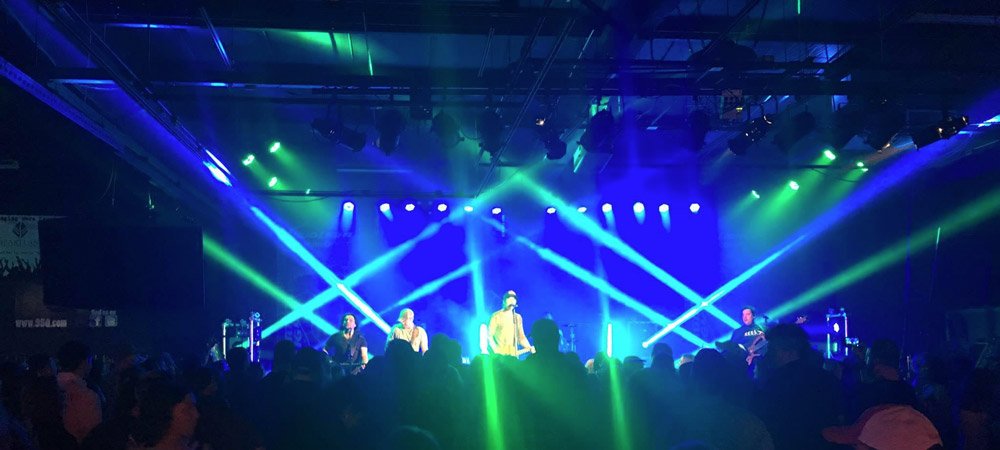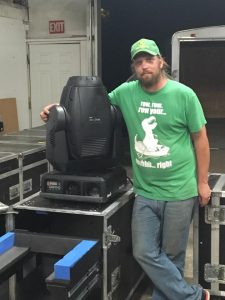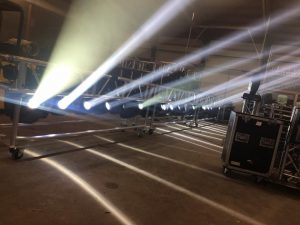Nate Wilson – Audio Technical Services
Posted by Fun DMC on May 4th 2017

 One of the most underappreciated elements of a show is the lighting. Most of the crowd knows that something cool might have happened on stage – a color change, a strobe effect, movers, fog, fire, etc, but no one really knows the detail that goes into making it all happen. For Fun DMC, our lighting show is an integral part of what we do, and we consider it essential to every performance. We’ve worked tirelessly to make sure every mover starts at the right time, every color looks just right, and every cue is on point. And we owe all that to Nate Wilson. Nate Wilson is a Lighting Designer for Audio Technical Services in Springfield, IL and cut his teeth running lighting for area bands. After a few shows lighting us up, we were hooked and have repeatedly gone to him for advice in building our own rig. He’s always more than happy to talk shop and point little guys like us in the right direction, despite spending his weekends running arena lighting for touring acts. To kick off the first installment of Ask A Lighting Designer, we absolutely wanted Nate to be the inaugural entry.
One of the most underappreciated elements of a show is the lighting. Most of the crowd knows that something cool might have happened on stage – a color change, a strobe effect, movers, fog, fire, etc, but no one really knows the detail that goes into making it all happen. For Fun DMC, our lighting show is an integral part of what we do, and we consider it essential to every performance. We’ve worked tirelessly to make sure every mover starts at the right time, every color looks just right, and every cue is on point. And we owe all that to Nate Wilson. Nate Wilson is a Lighting Designer for Audio Technical Services in Springfield, IL and cut his teeth running lighting for area bands. After a few shows lighting us up, we were hooked and have repeatedly gone to him for advice in building our own rig. He’s always more than happy to talk shop and point little guys like us in the right direction, despite spending his weekends running arena lighting for touring acts. To kick off the first installment of Ask A Lighting Designer, we absolutely wanted Nate to be the inaugural entry.
How did you get started?
You know I have often asked myself the same question! After advancing my career to a certain point I often said, “how did I get here?” It actually was there even when I was young. I used to try to change the colors of my bedroom around when I was young from black lights to about every little gadget that was illuminated from Spencer’s – I owned them all! I was constantly messing around with party lights. When I started driving, I turned the my love for illumination towards my car and everything else I could. Now, the trip into stage lighting was completely incidental – I was friends with a group of musicians that became very big in a short amount of time! They needed a guy to run the lights for them. I had no idea what I was doing but I was able to bump along to the beat of the music and cue up a strobe here and there. Looking back it’s actually quite funny – here I was on a big stage with 3 cues and not a clue. But as time went on I started to study on the basics and grew from there. Every show was progressively better and I seemed to have a natural knack for it. When the group disbanded I wanted to keep on going, so I started buying some equipment and freelancing for the local bands in the area while I enrolled to get a degree in Lighting Design.
What is your favorite show(s) you’ve done lighting for?
Wow that’s a tough one! To be honest, I have a few that stick out to me but I can’t seem to pinpoint a single one as my fav. I think one that’s at least up there is when I was called in to do Jefferson Airplane. It was a crazy experience and extremely fulfilling to be trusted behind the board with them. I mean, here I was working with a band that my parents listened to! That was sort of a aha moment for me.
What piece of advice would you give to a new band trying to make the night go easier on your stage?
Just to communicate with your LD.
If you move around a lot or like to jump out and break the fourth wall, let us know. Our first and foremost duty is to keep you where the crowd can see you! In the lighting world we call it “Lighting the Money” – that is the very reason we are there. The other advice I have for new bands getting onto the deck for the first time is this – the lights are bright and it will be in your eyes. Learn to adapt, because your fans want to see you – that’s why they are here.
What is your essential tool/piece of gear?
This sort of ties in with the last question. Apart from the obvious key components – consoles, etc. – I must have a good front wash that looks natural! Of course, if you’re doing a heavy metal act or something like that, then these rules do not apply. My front wash is always conventional lighting lekos or pars and filtered with a Lee #60 gel . These are the workhorses of my rigs.
How do you go about planning a design for a show?
 This is where the real work for a LD comes into play. Weeks in advance of a tour or show, I receive the song list. I listen to the music and build cues for the structure of the songs. I personally make a single cue stack that has multiple cues within it. I break down the intro, verse, chorus, and so into that stack. So when it becomes show time, I am pressing “go ” and advancing the cue at the right moment.
This is where the real work for a LD comes into play. Weeks in advance of a tour or show, I receive the song list. I listen to the music and build cues for the structure of the songs. I personally make a single cue stack that has multiple cues within it. I break down the intro, verse, chorus, and so into that stack. So when it becomes show time, I am pressing “go ” and advancing the cue at the right moment.
What’s your biggest challenge at every event?
I would say “Load in.” The equipment now is so advanced, there are always bugs to work out. There are times when it all goes up and the riggers are finished and life is perfect, but that’s not always the case. Most of the time there is a patch that needs altered, or a mover that needs reset, and so on. Knowing how to tech the rig is a huge part of it!
What’s the biggest unexpected catastrophe you have successfully overcome during an event?
Well, I can’t say there have not been a few, lol! One that sticks out because it was recent – I was doing a show at the convention center, and during the second band the whole rig went down! Blackness ensued. I had to get through a very thick crowd to get to the distro and every minute counted. Here I was frantically clicking my radio trying to get house lights turned on in the arena. Minutes felt like an eternity, but we had to get the rig onto another transformer and get it back online as soon as possible. After 6 minutes the problem was resolved and the band, as well as the crowd, didn’t miss a beat. The singer illuminated hisself with his phone and out came everyone’s phones to join in. It actually created a memorable effect started by a huge equipment failure.
What’s a typical event or day of event look like for you?
After a sleepless night because of a wandering mind, they all start early. Most of the time all my shows have crews that are supplied for me. I get together with them and assign people to proper positions and jobs. It always starts with the rigging motors, truss etc. Most of my rigs are what the call PRT (pre-rigged truss), where everything is already mounted and ready to be linked up. After the rig is lifted up to trim, I run the fixtures through all their paces and make sure everything is optimal. Then we take them into the air followed by another test and then recording positions in the console. After that, we go to catering before we are left with a celery stick and a smashed piece of pie.
What advice would you give to a band just starting out with adding stage lighting?
Keep it simple and follow the right building blocks like making sure you have downstage wash before you have strobes and movers. I see too many people buy all kinds of FX fixtures and forget about the purpose of stage lighting. Build your rig in this order:
- Downstage wash – make it natural no one looks good in multiple colors especially greeeeen
- Upstage wash – adds dimension and saturation
- Moving washes – side fill
- Moving spots – dynamic effects
- Strobes, blinders, etc – these are specials; use them sparingly
One last tip: check out the Mcandless method of lighting and follow the rules before you break them (that will come later).
What song are you sick to death of hearing?
Ha!!! Well, I guess I’m going to go in for the kill – “Uptown Funk.” Please god, make it stop….
